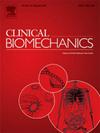Magnetic resonance imaging verification of anterior capsular impingement in the hip joint: A three-dimensional analysis
IF 1.4
3区 医学
Q4 ENGINEERING, BIOMEDICAL
引用次数: 0
Abstract
Background
This study aimed to clarify whether the anterior hip capsular ligament is impinged between the acetabulum and femur during hip flexion or adduction and to determine the difference in the distance between the femur and capsular ligament in healthy adults and those with hip pain.
Methods
Magnetic resonance imaging of the hip joint was conducted at the following hip positions: 0° of flexion, 60° of flexion, maximal flexion, and maximal flexion with adduction. A three-dimensional model of the capsular ligament and femur was constructed. The minimal distance between the femur and capsular ligament, termed the capsule-femur distance, was computed. Because a capsule-femur distance of 0 mm indicates contact between the femur and the capsular ligament, that is, capsular impingement, the distance in each position was compared for each group using a one-sample t-test. The capsule-femur distance in the various groups and for different positions was compared using a split-plot analysis of variance.
Findings
Fifteen healthy individuals and sixteen individuals experiencing hip pain were enrolled. The capsule-femur distance was significantly greater than 0 mm in all positions in both groups, and none of the groups had a capsule-femur distance of 0 mm. The capsule-femur distance was significantly longer in the other positions than in the 0° flexion position, and significantly longer in the hip pain group than in the healthy group.
Interpretation
Capsular impingement did not occur in either group, even during hip flexion or adduction. Furthermore, the capsule-femur distance was longer in the hip flexion and hip pain groups.
髋关节前囊撞击的磁共振成像验证:三维分析
研究背景本研究旨在明确髋关节屈曲或内收时,髋关节前囊韧带是否会在髋臼和股骨之间受到冲击,并确定健康成人和髋关节疼痛患者的股骨与囊韧带之间距离的差异:方法:在以下髋关节位置对髋关节进行磁共振成像:方法:在以下髋关节位置进行磁共振成像:屈曲 0°、屈曲 60°、最大屈曲和最大屈曲加内收。建立了关节囊韧带和股骨的三维模型。计算出股骨和关节囊韧带之间的最小距离,即关节囊-股骨距离。由于股骨囊-股骨距离为 0 mm 表示股骨与股骨囊韧带接触,即股骨囊撞击,因此采用单样本 t 检验比较各组在各个位置的距离。使用分割图方差分析比较了不同组别和不同体位的关节囊-股骨距离:研究结果:15 名健康人和 16 名髋关节疼痛患者参加了研究。两组所有体位的囊膜距离都明显大于 0 毫米,没有一组的囊膜距离为 0 毫米。其他体位的囊膜距离明显长于屈曲0°体位,髋关节疼痛组的囊膜距离明显长于健康组:解释:两组患者均未发生囊撞击,即使在髋关节屈曲或内收时也是如此。此外,髋关节屈曲组和髋关节疼痛组的囊膜距离更长。
本文章由计算机程序翻译,如有差异,请以英文原文为准。
求助全文
约1分钟内获得全文
求助全文
来源期刊

Clinical Biomechanics
医学-工程:生物医学
CiteScore
3.30
自引率
5.60%
发文量
189
审稿时长
12.3 weeks
期刊介绍:
Clinical Biomechanics is an international multidisciplinary journal of biomechanics with a focus on medical and clinical applications of new knowledge in the field.
The science of biomechanics helps explain the causes of cell, tissue, organ and body system disorders, and supports clinicians in the diagnosis, prognosis and evaluation of treatment methods and technologies. Clinical Biomechanics aims to strengthen the links between laboratory and clinic by publishing cutting-edge biomechanics research which helps to explain the causes of injury and disease, and which provides evidence contributing to improved clinical management.
A rigorous peer review system is employed and every attempt is made to process and publish top-quality papers promptly.
Clinical Biomechanics explores all facets of body system, organ, tissue and cell biomechanics, with an emphasis on medical and clinical applications of the basic science aspects. The role of basic science is therefore recognized in a medical or clinical context. The readership of the journal closely reflects its multi-disciplinary contents, being a balance of scientists, engineers and clinicians.
The contents are in the form of research papers, brief reports, review papers and correspondence, whilst special interest issues and supplements are published from time to time.
Disciplines covered include biomechanics and mechanobiology at all scales, bioengineering and use of tissue engineering and biomaterials for clinical applications, biophysics, as well as biomechanical aspects of medical robotics, ergonomics, physical and occupational therapeutics and rehabilitation.
 求助内容:
求助内容: 应助结果提醒方式:
应助结果提醒方式:


